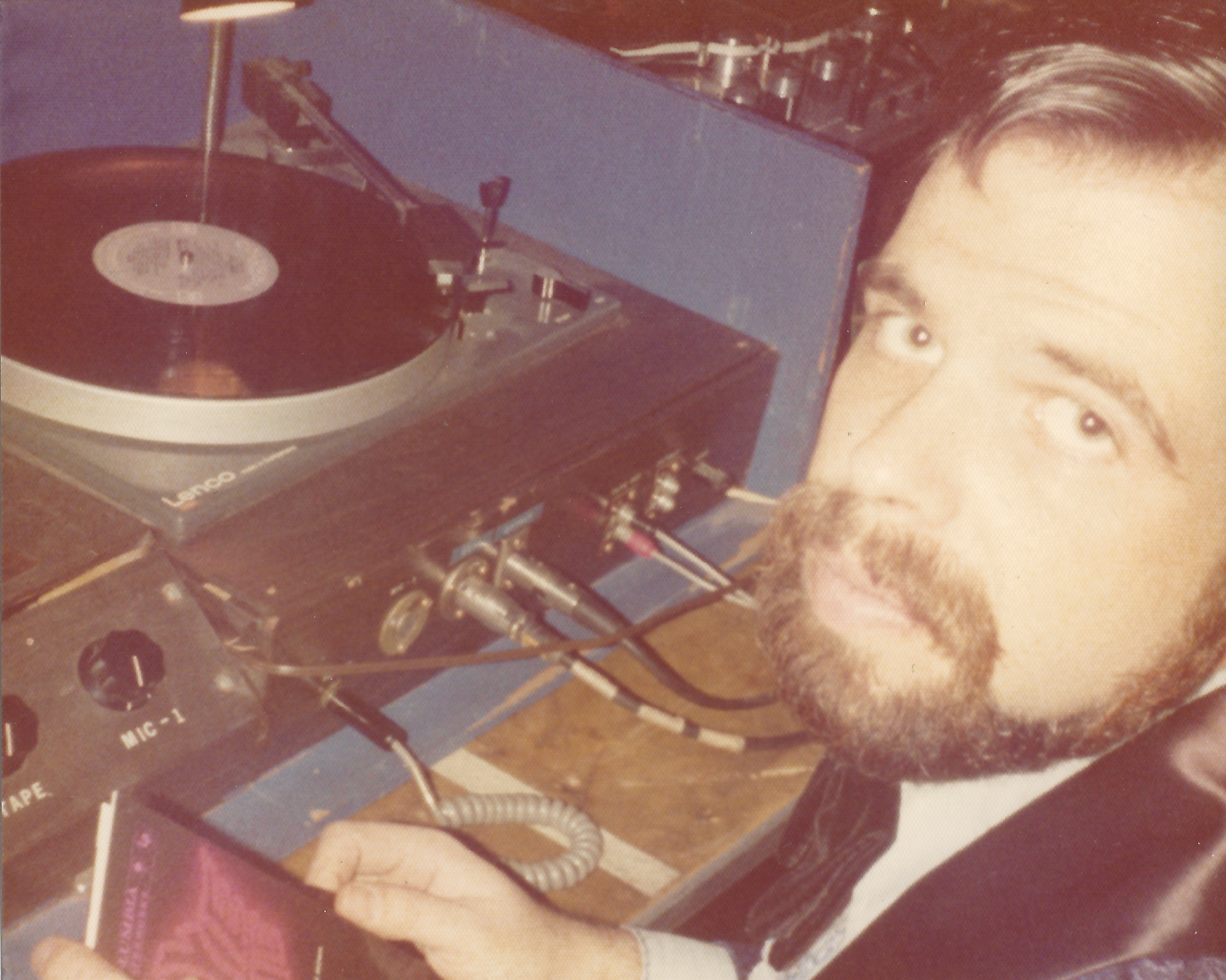Interview: Bob Casey, NYC Disco Pioneer
From the DJ History archives: Frank Broughton gets the lowdown on the beginnings of New York’s nightclub scene

Bob Casey was an armed forces DJ in Vietnam, and as a sound engineer was one of the early pioneers on the New York disco scene, working in the same era as David Mancuso’s sound associate Alex Rosner. He also ran the short-lived Melting Pot disco fanzine, an attempt to unify and document New York’s DJs.

But he’s perhaps best known as the first DJ to work from two decks at once, with his homemade double decks from 1955 featured in the opening page of the book Last Night A DJ Saved My Life. In this interview from 1999, published here as part of RBMA’s partnership with DJ History, Casey discusses his innovations using two turntables at once and the Fire Island scene, as well as the different skills and personalities of some of the earliest DJs in New York.
When did you start doing sound?
Well, my father was in the business. I came back from Vietnam and I was working at WMCA and WNBC. I was in armed forces radio. I was one of the Good Morning Vietnam guys. And I just went to my first club in 1970. It was a little place out in Fire Island where they had strings of Christmas lights hooked up to what was known as a color organ, a piece of electronic equipment that took the high frequencies and would create light on one, and the mid-frequencies on another, so if you had three strings of light, the tweeters, the mids and the bass would run concurrently. They used to do strings of those around the room; that, a strobe and a mirror ball, and that was your light show. That was 1970.
I left NBC in 1971 or ’72, I started my sound company and I built one of the first really sophisticated systems, which was at the Continental Baths. That opened up in 1972. I built a system out on Fire Island first, and people were asking me to do their apartments and stuff in the city. Bette Midler’s last appearance at the Baths, the soundsystem failed, the air conditioning failed, I was there. It was just such a mob, because by then she was a star.
Was Barry Manilow playing the piano?
No, that was after Barry Manilow. They separated in ’71, I think. Anyway, because the soundsystem failed they called me. I put in something like 3500 watts of power, which was a lot for that. I think I had 16 Bose speakers suspended from the ceiling, these birdcages. It was such a low ceiling, there was no place you could put anything.
This was in the bottom of the Ans-
Ansonia Hotel. Which ended up becoming Plato’s Retreat.
Oh, that was the same place?
Yeah. If the walls could talk!
Who was DJing then, when you put the soundsystem in?
Bobby Guttadaro: Bobby DJ. In the summer of ’72 out in Fire Island there was five Bobbys working out there. You had Bobby Bartender, Bobby Doorman. I was Bob Casey – somehow I kept my name. And I gave Bobby the name Bobby DJ, ’cos nobody could say his [last name]. I actually hired him. He came out there on a trial visit in 1971. In the fall of ’71 I heard Bobby playing at a little club on the Upper East Side. It was basically a bar, two automatic turntables, no cue system, nothing. You just heard the vibration of the needle and that’s how you knew the record had begun to play. It was really very, very primitive.

But they were doing pretty sophisticated mixing things with very primitive equipment back then.
Very, very much so. I actually still have tapes of that stuff. I have tapes of Bobby in the Ice Palace in ’72 and things like that. I consider the beginning of disco was probably the mid-’60s. Some guys would show up with some turntables in lounges of bowling alleys and places, which today we’d call singles bars, but then it was just a lounge. As kids were able to drink, especially in New York, at 18, these guys would bring turntables and plug them into the jukebox amplifier. The jukeboxes had some speakers around the lounge. That was probably the very beginning of disco.
Now, I was running dances in the ’50s. I’m 55 now. And 1957, fall of ’57, my first year of high school, I ran my first dance. In 1958 I appeared onstage with two turntables. With a switch – I’ll take you back, I’ll show it to you. I was getting ready to throw it out and some guy says, “Don’t you dare throw it out, that’s like throwing out the first car.” I had two volume controls and a switch, ’cos I wanted to repeat. I wanted a Dick Clark visual and a radio audio. I wanted much more music.
Sock hops didn’t begin till the ’60s. In the ’50s they were called record hops. ’Cos you still had some bands and stuff like that. I actually had asked my mother, “Did you ever dance to records?” My mother was the swing era. She said only in what they used to call juke joints; that was to jukeboxes. It wasn’t until the war – kids used to have teen centers, during the Second World War – and somebody would show up with a phonograph with a stack of records and they’d dance in the gym. That is truly the beginning. By 1945 kids would assign a group of fellow students to pick out some of the records for that night.
OK, record hops. At the time, let’s say the 1950s, a guy would show up, sponsored by 7Up, so you hung up some 7Up posters, and you promised to serve 7Up at your dances, you bought the 7Up. This guy showed up as a pepper and saltshaker for the 7Up. He ended up with a little 45 record changer, a little box of 50 records, and he’d take the high school gym system, put the microphone in front of his little loudspeaker, he’d have a little microphone, smaller than your Walkman.
He’d pick it up and say, “Well, that was Brenda Lee and ‘I’m Sorry’ and now we have Elvis Presley.” He’s talking while the record’s dropping on the repeater, and “OK, drink up your 7Up folks.” And that went on until me, when I had two turntables with me. Nobody else had anything like that.
What was your idea behind that?
Again, I wanted to have much more music. I wanted to be able to come out of one record and go right into the next record. Turn it down and talk over the record and bring it up.
What year was this when you did that?
’58.
And to your knowledge, no one did that before?
Well, again I was born and raised in New York, that’s all I could say. I don’t know if some guy did it in California or nothing. I never heard of it...
What was the event that you did that at?
Saint Eugene’s, Yonkers, New York. That was our parish. Anyway, by the time I went into the service in 1961, there were some other fellers that were biting at the bit taking over running dances and stuff like that. I did it for four years in high school, completely dropped out of school, I was a complete jerk when it came to school, but I lived for my dances.
I came home on leave and I remember going out with some guys, and we went to this bowling alley lounge. We didn’t go to bowl, we went to hang out, pick up, whomever. And that’s where I saw some guy set up some tables and he had two turntables and it was plugged into the jukebox soundsystem. This is 1964 or so.
Small acts were playing in the lounge. Sam the Sham and The Pharaohs, I saw them. They used to do lounge acts. And then a disc jockey came on, in between the bands. But that didn’t last long because the people, after hearing the bands, they’d hear the records, they didn’t want to go back to the band. Who the hell wants Billy and his Bluebells when they could all of a sudden get Elvis and everything else?
This probably coincided with music getting more exciting for a younger audience.
Definitely. Now in New York in the middle, late ’60s, that was the era of the end of the coffee houses and stuff like that. It was the beginning of the drug period, and they used to have what they called juice bars – there’s probably not even a shadow of them left anymore. But juice bars were basically places that didn’t have liquor licenses. A lot of kids hung out there.
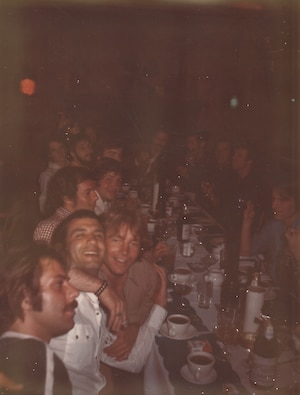
Alex Rosner built some of those first systems, and they were pretty good systems for the time. Rosner always used very good equipment. Rosner was a guy that used Macintosh amplifiers and Thorens turntables and stuff like that. He used a lot of good equipment. And it was during that period that Alex Rosner came out with… Oh, you had the Round Table, and Francis [Grasso]. I remember going to this place called the Round Table, and they had drag acts there. That was the first time I saw Francis. To my eyes, of the modern DJs, Francis Grasso was the beginning.
What was he doing that was different?
He had a Rosner system – but even then it was primitive – he was using microphone mixers, two of them, because they didn’t have a good stereo mixer at the time, to play.
Did he have cueing?
I don’t remember if cueing was out. Right about that time was when cueing began. And cueing was just a tap of the phono pre-amp, and you had a toggle switch, phono one or phono two. But even if that was the case, most places didn’t have it.
And what kind of music was he playing back then?
Popular, non-bubblegum popular rock.
Very much rock?
Yes.
And how was he mixing the records. Was he segueing?
Oh yes. He was the first one I really saw mix. And it was because of watching Francis… I’d say that my greatest claim to the disco industry is I probably invented the cueing technique. Because I worked at NBC. NBC had turntables that were literally 18-inch [deep] platters that were made out of solid steel. Underneath they had a motor the size of one that would be for a washing machine. Seriously, it was like a volleyball, a little bit smaller than a volleyball.
Now the felt on those turntables was glued to this platter. You had to cue your record. You’re listening in one ear to the announcer, the disc jockey on the air, and in the other ear, you have your cue on. And you keep cueing, you’re cueing, you’re cueing [i.e. holding the record back], and the disc jockey would be talking, he goes, “And that’s it, we’ll be right back.” And you let go of that record, right away. And the second he would say it, it was less than a quarter of a turn of a 45, bang she was up to speed and playing.
I watched Francis [Grasso] and he couldn’t do that. He couldn’t do that. And he would constantly, he’d back the needle off a little bit, back the needle off a little bit. You’d hear it begin, back the needle off a little bit, back the needle off a little bit, so he’d back it off and get to his end [of the previous record], and bam, a little volume, a little razzamatazz, anything to cover up a lousy mix, but for then it wasn’t lousy, it was premier.
I was the one who took a felt pad and put it on the turntable. Then we found out that the turntable motors weren’t strong enough to handle that. And so we didn’t glue the felt down to the turntable, we let the felt fly free. On the turntables. And that began that. Bobby was the first one to take some paper record jackets from 45s and put that under the felt to make it even more slippery. And it was watching Francis work that gave me that idea. So when I was out on Fire Island, that’s when I started playing with the turntables and started doing that stuff.
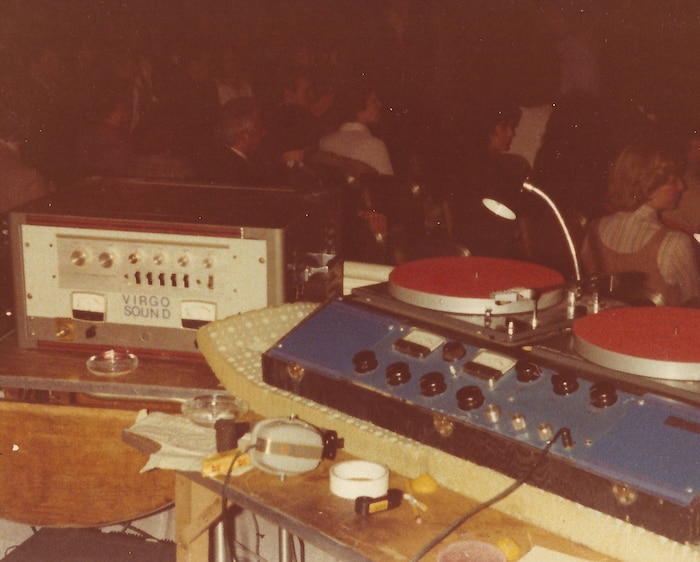
So when was the first time that that was a possibility. Where did you do all this?
1971, out in Fire Island. Then they had Thorens turntables and there was two kinds of Thorens turntables, the TD 124 that actually had a gizmo on it, which had a platter raised above the platter and you moved this little knob and the platter dropped down and it would take right off. I actually have one of those. And Alex was putting those in; they were very strong turntables, very good, top dollar, best for their time.
They were built for radio DJing?
No. Well, you know it’s strange, I wonder what the market really was then. ’Cos radio already had their own equipment then. Gates and Sparta, and things like that.
Once they had the slip-cueing, how quickly did they start doing things like beatmixing?
’72. Immediately. Disc jockeys were so eager to do tight mixing. Every little nuance of tightness that you could give them they absorbed immediately. Immediately. A lot of guys used Thorens TD125, which were belt-driven turntables. They had no torque. You could barely touch those things; you had to be so light with them.
What other little technical developments were there around that time?
Well again, the quality of the equipment, the tweeters, the tweeter arrays. Volume! Volume became intense by ’72, again spurred on by guys like David Mancuso. When I built my system at the Continental Baths, I met David for the first time, I’m sure I didn’t impress him in the slightest way. He was eons ahead, as far as sound quality… He was Saks, I was K-Mart. Right around that time Richard Long began. I met Richard Long in 1972; Richard Long was building his own mixer. In 1972 I built my first mixer.
When did the Bozak come out?
1971 – nobody could afford that. In 1972 I met Michael Cappello. All I remember is this skinny guy with his long black hair, and with every mix he’d flip his head and his hair would go flying back. That’s all I can remember of Michael Cappello. He was a good looking guy, had this long black hair and he’d be dancing, dancing, dancing, and he’d do a mix and throw his head up and his hair would mix as well as the music did. He was working at a club called the Limelight. Which is no longer there. It was down Seventh Avenue and Tenth Street I believe.
I still remember the system actually. It was Altec 604s, there were six of them in the Limelight, and a couple of Mackintosh amplifiers and the Bozak mixer. And the music was distorting because everything was going as far as it could go. Which was never far enough. Every disc jockey that’s buried should have on his tombstone: “Too much ain’t enough.” No matter what you put in, they wanted more.
The Limelight was packed, constantly mobbed. So that’s where I saw Michael play, and at that time he was right up there. Bobby Guttadaro had just begun playing in a little bar on the Upper East Side. I don’t remember the name of it, and he was using Garrard record changers, what we used to call Rumb-Olas. At one time Garrard was the best, in the early ’50s. They came out of England, and if you had a Garrard turntable in the early ’50s you could get no better. They were beautiful. They were just gorgeous machines. Double belts. In other words, the motor went to a belt, which went to a wheel, which went to another belt, which went to the drive wheel. Garrard turntables were the first ones that were adapted for magnetic cartridges. In any case, by 1972 disco came above ground. The juice bars are where the seed of disco was watered.
But there was an underground gay scene as well. Were they completely separate?
No, it was a little bit mixed. But it was primarily gay, a little bit mixed.

So these juice bars were primarily gay?
Yeah. At least the ones where the music became important. I’ve yet to hear of another spot than Fire Island where disco came to its formality, where you had two turntables, where you had a mixer consisting of at least two knobs where both records could play at the same time, with at least a toggle switch for cue volume for cue of each turntable, so the disc jockey could go from one record to the other record and make it a perfect mix. This all happened in Fire Island. This all existed in 1970. It got better by ’72.
Who was DJing in Fire Island around this time?
Don Fenley and he was down at the Pines, which is the next community down. The summer of ’71 Don Fenley had the hottest thing going, and he was at a place called the Sandpiper, which is now the Pavilion at the Fire Island Pines. Don was known for mixing James Brown, ’cos people danced to James Brown. And I said, “Think seriously, you could drop a needle anywhere on a James Brown record and you could mix it.” Dan-dan da-dan, get up, da da da. There’s nothing to it, but Don Fenley was known for really doing that really good. I don’t know whether there was any star DJs back then out on the Island. In the city you had Francis, and you had Michael Cappello.
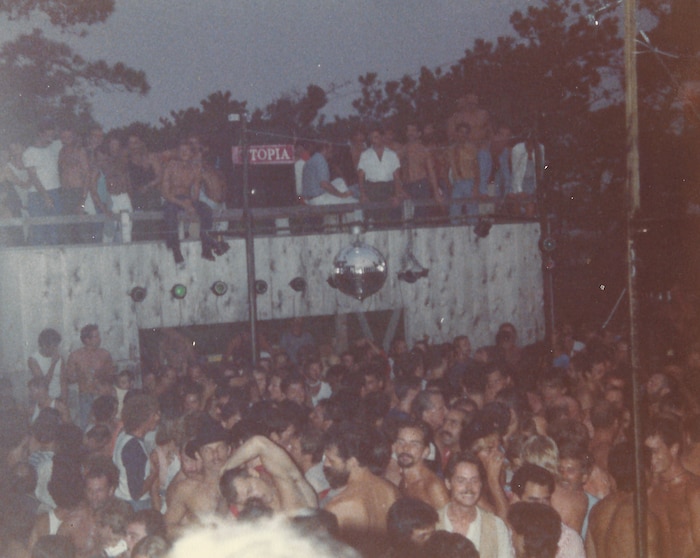
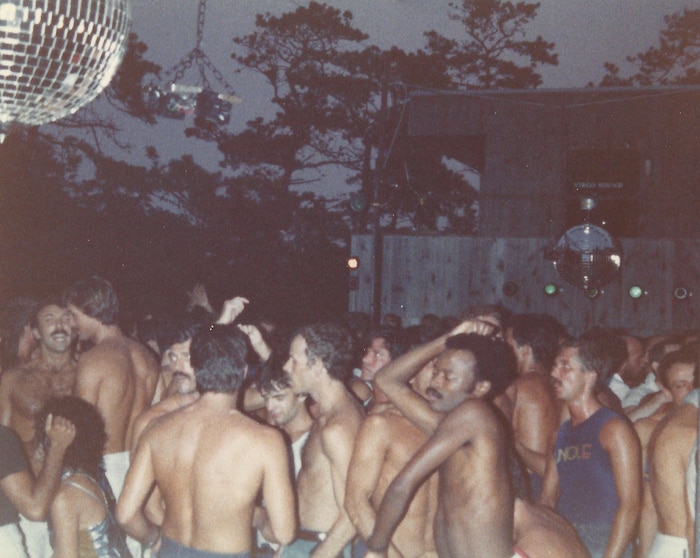
And before Francis, there was Terry Noel.
I never heard of Terry Noel. Whereas Francis was at the Sanctuary… and then the Haven. The Haven is a piece of history. The cops in NY use to literally walk into clubs and shoot out the loudspeakers, would think nothing of putting an elbow in some faggot’s face. Seriously, that was the scene, and the Haven was the last time that happened. And that happened, I think it was two years after the Stonewall, right across the street from there. The Haven was 1 Sheridan Square. And I was in that room after it had been trashed. It had been locked up, and they were gonna do a theatre in the round and they wanted me to do the sound for it, and I saw that place trashed. I couldn’t believe it. It was just destroyed completely.
And they smashed up the system?
Well, they got a few things out of it. I possess the original amplifiers from the Haven. Dynacos. I had an original Alex Rosner mixer, he used to build these little red mixers. But, again, all this stuff was still underground. I would say the beginning, when it came above ground, was a club named Le Jardin. John Addison’s Le Jardin. That was June 13th, 1973. Diana Ross was at the premiere. That hit the papers, and all of a sudden “discotheque” became in and popular at that point. [Le Jardin] was in the basement of the Diplomat Hotel on West 43rd street, and I’d say that was the spot where it really came to the fore, where by 1976, ’77, Beefsteak Charlies were having discos. They’d get some girl with big tits to stand behind two turntables: “Aww, we got a disco.”
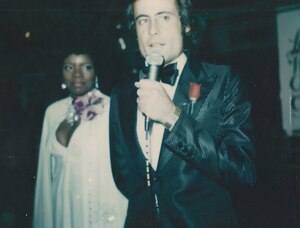
What about Cheetah?
Then the black clubs, now the black clubs. I’m a white guy, so I had limited access until I started the Melting Pot and the National Association of Disco Disc Jockeys. When I did that, the record companies thought I was trying to form a union. Or the club owners thought I was, which I wasn’t. I’m very anti-union. I felt very sorry for the disc jockeys, that they had nothing to back them up. The owners of the clubs were playing them horrible money, and if you didn’t like it, it was, “Get out. I got plenty of guys lined up to play in your place.” And those guys, they’d play for nothing. They’d pay you to play, they really wanted to play, in the worst way. If a kid made a hundred dollars in a night that was big bucks.
Were there exceptions to that?
Well, I think the security of a job became your pulling power. In other words, Francis became the house disc jockey. He was part of the club, and so, there was no contracts, but it was an unspoken thing that “you are our man.” So you’re guaranteed your job. You don’t have to worry that some guy’s gonna come in and take over your job. So I think they traded that off in place of having a lot of money. It was still minimal right up into the latter ’70s.
And they were treated like waiters?
Oh yeah, really. But then again, what happened with disc jockeys, they basically had their goals: sex, drugs, free records. And that was it.
So nothing’s changed then…
I was trying to formalize the disc jockeys. The thing is every kid that had two turntables, all of a sudden he was a disc jockey. And everybody was soliciting the record companies. A guy would come in: “Hey, I got some new product for you here.” And he’d have this big bag and everything. And then he’d very quietly drop a 20 dollar bill in your pocket and say, “Give this a good play, won’t you?” And the thing is I met with the record companies. I had a big meeting, a public meeting, where I invited the disc jockeys. And the disc jockeys didn’t want me to upset anything, because they wanted to get the records from the record companies.
I said, “Why don’t you record companies use the DJs as a good test barrier of the product for today? The disc jockey doesn’t care about your money. He wants to put that record on and he wants to make people scream for it. If it’s good, he is your best way of getting it out there. If it’s bad he’s the first one to tell you. Why can’t you guys leave it like that?” You have no idea. I felt like Pat Boone in the Meat Rack...
When did you actually start it?
July of 1974. Melting Pot was the magazine. Here’s how that got started. One night my friend Joey says, “Oh Bobby, let’s go to David’s Pot Belly,” and I go, “What’s that?” And he goes, “Oh, that’s a little ice cream place down on Christopher Street. All the guys hang out there.” And back in those days at 4:30 in the morning we’re in a table like you and I are in right now [a diner booth], and they might bring a couple of chairs over: [points to the imaginary people] David Rodriguez, Michael Cappello, Bobby Guttadaro, maybe Nicky Siano, I was there. Joey used to play the Continental sometimes. Maybe Larry Levan. Frankie Knuckles was just beginning right around then.
And everybody’s sitting there and they go, “Oh Mary, did you see the group on this… well let me tell you, this one dropped dead yesterday…” and you heard this dish going on. I said, “God, if I could put a microphone down here, what a thing this would make for a sheet for the week. Here’s your pics of the week. Here are your hot records. This is what’s happening. This is the real thing.” And it’s how it got the name Melting Pot, from David’s Pot Belly.
How many members did you have?
About 200.
What was the peak number?
That was it. It did nothing but climb. It was just beginning. And the thing is I had to survive. It was costing me more to do. On my sound company, I was driving myself into bankruptcy.
Who were the members? All club DJs?
That’s where I met the black DJs and I started getting involved with the black DJs. I didn’t know about the guys that used to play the beaches, down in Brooklyn and stuff like that. That’s where I got to know Flowers. Flowers is gone now, but he is considered the master of Brooklyn, of black disc jockeys. Cameron Flowers I think his name was. He was known as the grandmaster.
He was the first Grandmaster.
I think he was. And respectfully he’s still given that title. It’s like he retired undefeated. Alfie was another black DJ that I started highlighting. Mitch was this cute little kid, and he wanted to be a disc jockey and he would go to the clubs and write down the orders. “What are the orders?” The orders were the order in which the guy was playing the records. He couldn’t understand how he played records and the kids didn’t get into as much of a fervor as this guy, and he’d write down the orders. And he still never got big, because the idea is it was never the same order every time.
So he was the first trainspotter.
He would take the book and write down what disc jockeys played on a night. Most disc jockeys didn’t like that. They really didn’t care for it.
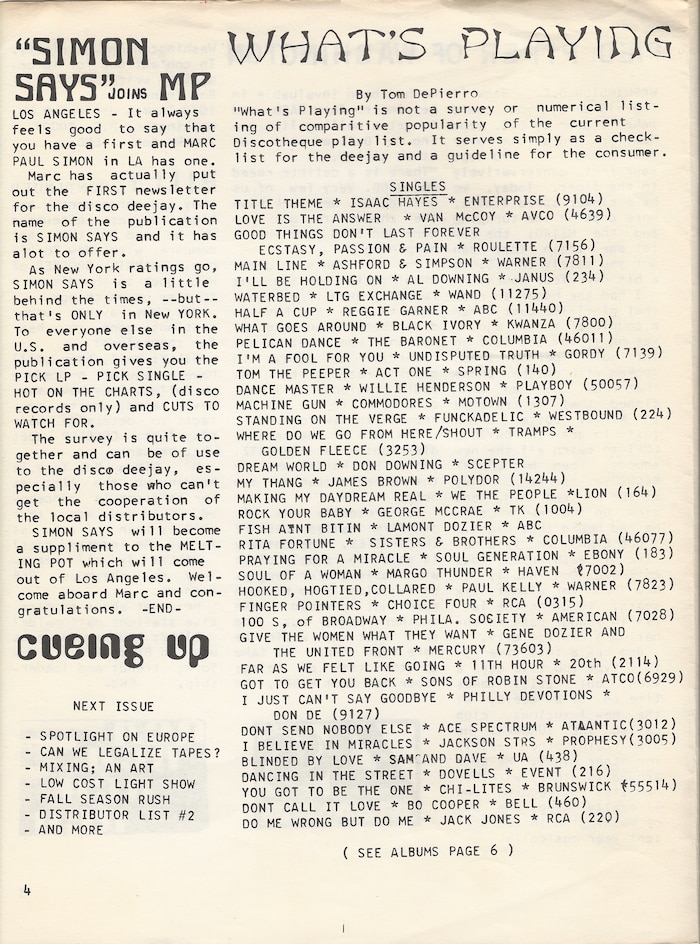
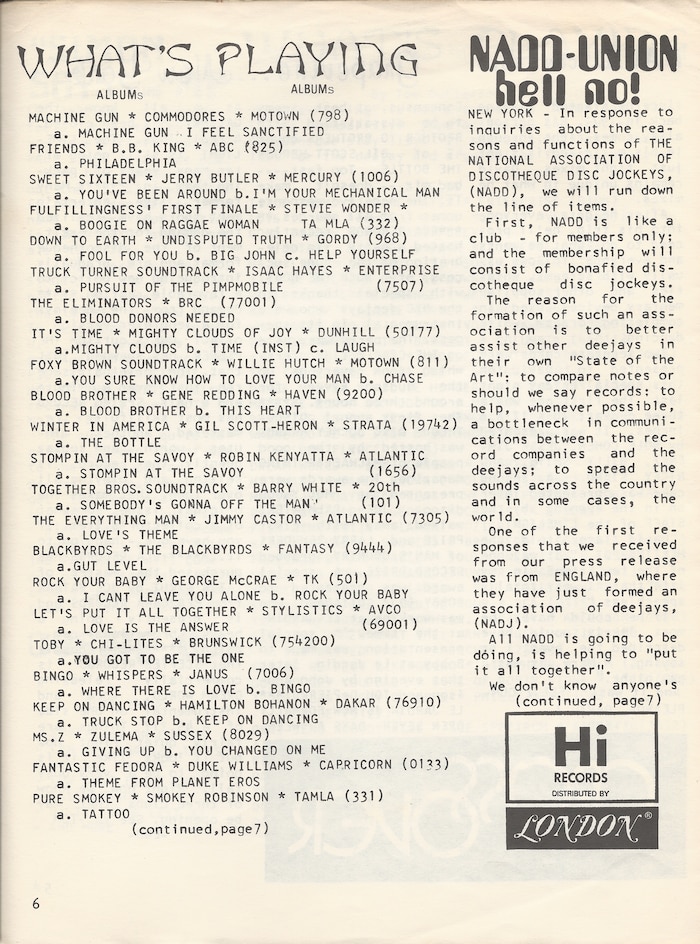
Was Frankie playing at that time [1974]?
Just beginning. He was filling in for Larry [Levan]. He was Larry’s protégé.
Larry was very much David [Mancuso] and Nicky [Siano]’s protégé, as I understand it.
David, yes definitely.
’Cos Nicky’s take is that if he hadn’t got lost in drugs, he would have been Larry Levan.
Now I’ll tell you what. I knew Larry Levan to the point where I came this close to hitting him with a hammer in his head. I remember that. I remember Nicky hated my mixers, because I used to use... He called them tinker toy knobs, these big knobs, they were all broadcast knobs. The thing is, they were two totally different guys.
I remember driving down to Nicky’s one night. I very rarely went to clubs. And most I ever did was smoke a joint. To this day, joints and poppers and I’m fine. Course somebody says, “Here, this is ecstasy, just give it a try.” Now the thing is that Nicky Siano was much more of a quiet guy. He had his people around, but he was a different persona. And Nicky used to have a little, the Nicky twist, he’d stand there like this [doing a little twist dance, shaking his butt a little while he mixes records] next to him was Robert DaSilva, this little white boy, blonde hair, cherub.
He did the lights.
Yeah. And these two little guys are doing the hottest black club in the world. To me, little conservative me, it was the hottest disco I was ever at in my life. Why, because they began with the basic color black! And they worked it up from there. There was no neon. There was no automated anything, there was a few light switches, a couple of light pedals, that’s all it was. I only saw the first Gallery once. I got there and it was really crowded and it was a firetrap. But that’s where they began this thing. Also, they’d grab the mirror ball and give it a spin. And you could see the sshwwwoo all over the place. That’s where the whistles began. That’s where everything like that began. But the thing is, they began with black.
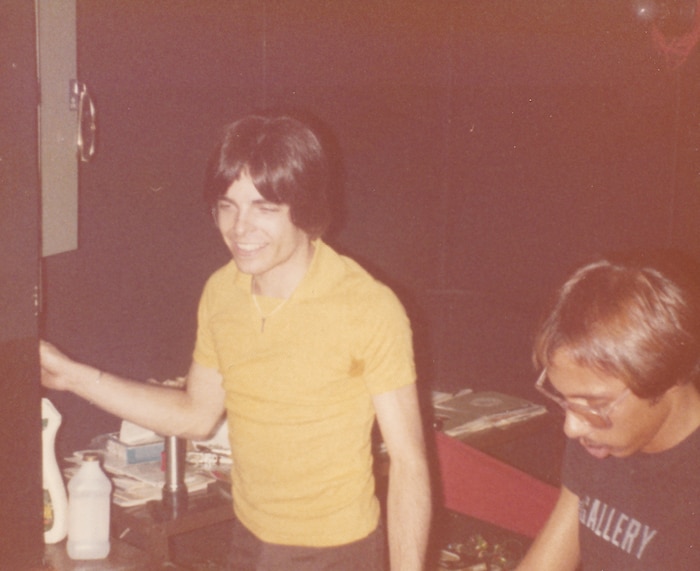
Nicky Siano took his sub bass beyond. He wanted this heavy sound. Nicky Siano, his Richard Long tweeters, he had Alex Rosner stuff also, but he wanted the crossover points to be so much that when you took out the center, you could hear no program [i.e. song], you could hear tss tsss tss [hi hat], and bummmm bumm [bass] and every once in a while, especially in the black clubs, with the dancing, everybody would be so together with it, they’d be sometimes singing and Nicky would bring it up and then all of a sudden BOOM! It was flawless, and the lighting was with it perfectly.
When the room went to clack [i.e. the music] it would be black [the lights]. And yet there’d be a couple of hundred people in there dancing. And you couldn’t see your hand in front of your face. And it’d be so intense. It would be so intense. And then, all of a sudden, something would come on. Then lights would come on like normal, and everything was dddddd [climactic brass stabs]. Nothing automated. It was perfection. It was perfection.
How did things change when these DJs became big famous names and they had a marquee value of their own?
In the straight world, it didn’t. In the gay world, it did. And that started at the end of the ’70s. That started with The Saint. That’s where the change was in the wind. Because, by then, drugs were not prevalent, it was a necessity. You went to The Saint, sometimes you wouldn’t even get there until one or two o’clock in the morning. And you knew you were gonna party till noon. And the thing was “OK, who’s playing tonight? What am I gonna take?”
Because you knew their different styles and you’d tailor your drugs accordingly.
If Roy Thode was playing, it was get down, fuck, get busy, and that was it. Roy was a dear friend. He was a protégé of Bobby DJ, and Roy used to play out on the Island. The Island was perking a lot of little straight clubs, but the gay disc jockeys played there. The straight disc jockeys never maintained, cos they didn’t have their heart and soul into the music the way the gay disc jockeys did. So they built much more of a following.
Was there resentment between the different DJs?
No. They all wanted to be like the big guys, but there was no resentment. It was always, “Hey mister, give me a chance.”
Who was the first DJ who could say to a club, “Fuck you, you do what I say”?
Well, by the time of Studio 54 in 1976. I was the one who gave Studio 54 its name by the way. This is honest to god truth. There were two guys by the name of Uva Harden and Yoram Polany. It was so funny to have an Israeli guy and a German guy who was very in love with Hitler, both of them together. They had more or less got a retainer for the building 254 West 54th Street, this old theater, which used to CBS Television Studio 52.
And when they came over to America, they heard about me and about Bobby Guttadaro and Richie Kaczor and wanted to open this club and wanted it to be the best. They did not want to compromise, and they took me and Bobby and Richie and they put us on retainer. They paid us a couple hundred dollars a week to do nothing but stand by. But the day they say go to work, you go to work. I negotiated their contracts to make sure they could play up until that time, and they demanded a one-week notice. And this they allowed. And they then put in for their liquor license. They got everything together.
The address was 254 West 54th Street. 54-54. And, any time you get a construction site, the first thing you get is a phone number. And guess what? There was a 54 in the phone number. And we’re sitting there, “What should we call it?” And they were coming out with some real abstract European type name. And I said, “It’s a studio. It’s a television studio. Let’s call it Studio 54.” And that they liked.
But what happened was one of the major investors, Marlborough Galleries, was in the middle of a lawsuit because they were selling some guy’s artwork – millions of dollars – without giving it to the rightful people. Right next door to the Attorney General, who was fighting these people, was the Liquor and Beverage Authority. When they found out about Marlborough Galleries, they didn’t deny the liquor permit, but they didn’t issue it within the eight weeks and they couldn’t wait any longer, so they dropped their option. And, that very afternoon, Steve Rubell came in and put down $15,000 cash, and they had the room. They retained the name only, because Uva Hardin was involved in it, and the rest is history.
But Richie Kaczor still played the first night and Nicky Siano played the second?
I think Richie did play the first night, and I think Richie was the first house disc jockey of Studio.
Nicky told me he played the second night.
I don’t know. But Nicky was never known for Studio 54 at all. So Richie Kaczor could be considered one of the first house disc jockeys. But, no, Don Fenley was the house disc jockey at the Sandpiper in 1970. Bobby DJ was the house disc jockey. Francis was a house disc jockey. So this all goes back. When did disc jockeys have their power? I don’t think any of them had power...
…to threaten to walk out if they didn’t like something?
It never really existed. I think the disc jockeys try to promote this. I could be wrong, but I think to this very day, if Frankie Knuckles was to quit and say I’m not coming in tonight... One, that’d be very unprofessional for him and that would go everywhere, but if he should quit I’m sure they could find a replacement immediately. I don’t think a disc jockey has that power. I don’t think he ever would. As long as there’s somebody in the wings, nobody has that power. I mean Jack Parr walked off television, and Johnny Carson was there the following day. It would be a nice thing for the disc jockey to say, “Lookit, if I don’t play here the place is gonna fold...”
This interview was conducted in New York City in February 1999. © DJhistory.com
